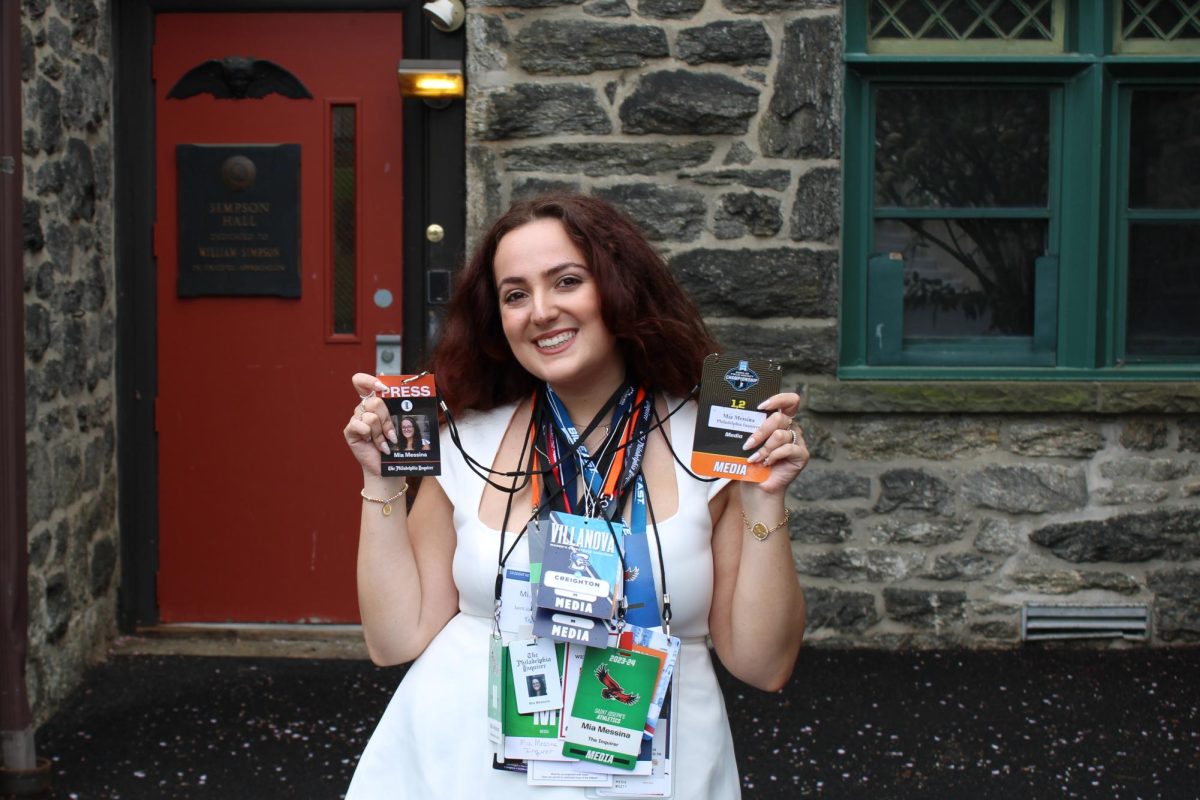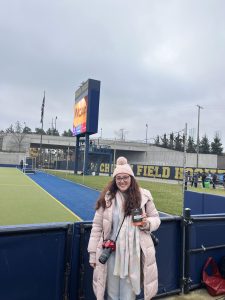
Mia Messina ’25 poses with her media credentials from the past four years. PHOTOS: MIA MESSINA ’25/THE HAWK

As a woman pursuing a career in the male-dominated world of sports journalism, I often feel isolated. With that isolation comes a feeling of vulnerability, and that’s when the imposter syndrome sets in.
And yet, my career so far has been full of highs that should convince me otherwise. My article about ESPN bracketologist Joe Lunardi appeared on the front page of the Philadelphia Inquirer in March 2024. I covered the NCAA Field Hockey Championship from Ann Arbor, Michigan in November 2024. I wrote Eagles playoff broadcast stories for the Inquirer, including one this year about the Super Bowl. I’ve also covered the Broad Street Run, Dad Vail Regatta and Penn Relays. In all, I’ve written over 100 articles across my four years in college and won state and national awards for that work.
These are the times when I glimpse what I am capable of and have achieved, and I feel so sure of myself as a sports journalist.
And then are times when I don’t. When men talk over me in conversations about sports. When I am laughed at and ignored in those conversations. When I am made to feel small, like I don’t belong. As Sports Editor for The Hawk, and as one of only five women in The Hawk’s nearly 100 year history to serve in the top sports role, I have spent the past two years facing challenges that have made me doubt myself and my abilities, constantly feeling the need to prove myself. Maybe some of that came from me internally, but a great deal also came from being the only woman in more press conferences than I can count.
Last year, a man I never met friended me on LinkedIn just to tell me he disagreed with the most miniscule detail of analysis I wrote about a St. Joe’s men’s basketball game. He thought I should have named a rebound off a free throw as the key moment in the game. I said the free throws were key.
He didn’t think I was good enough.
While I was in Ann Arbor covering field hockey, a man replied to my post on X ridiculing me for not including in my article the fact that one of the St. Joe’s players transferred from the school they were facing that game.
He didn’t think I was good enough.
This past year, I wrote a series of stories about what it means to be a woman in the male- dominated world of sports. These stories have helped me understand this ecosystem I’m a part of on a deeper and more nuanced level.
A fellow St. Joe’s student told me these conversations about gender discrepancies in sports need to be more nuanced.
He didn’t think I was good enough.
When I started pursuing this career, I was terrified. I never thought anyone else would understand the feelings of isolation I was dealing with. But, in the last four years, I have also had conversations with other women about sports. We have laughed at some of the things we’ve had to endure. They have given me confidence and a space where I truly felt like I belonged in sports journalism.
For one story, I spoke to Christy Selagy ’15, M.A. ’17, a former sports editor for The Hawk. We spoke about why we felt called to give more attention to women’s sports in our media coverage. She understood how I felt.
For another, I spoke to Elaine Shenk, Ph.D., professor of Spanish and chair of the languages and linguistics department, and Stephanie Tryce, J.D., assistant professor of sports marketing. We discussed gendered language in sports and how it perpetuates stereotypes. They taught me to be more aware of the way I discuss sports if I want to be more inclusive.
Then came the women from the first women’s basketball team at St. Joe’s. Kathy Garvin ’75, Cathy Cosgrove ’75, Kathy Langley ’78 and Mary Sue Simon ’78. They told me stories of what they had to endure not only as the first women’s basketball team at St. Joe’s but also as some of the earliest women to attend St. Joe’s. They paved the way.
I have never been as nervous for an interview as I was when I interviewed Claire Smith, the first woman to cover a Major League Baseball beat as a reporter. She shared stories with me about the struggles of being a Black woman in the world of sports journalism in the 1980s. She broke the glass ceiling for every woman who came after her.
I spoke to Lily Shimbashi, the CEO and founder of sports media platform Sportsish. She told me about her journey from broadcast journalism to founding a platform with the goal of engaging with women sports fans. She reminded me that femininity and a passion for sports can co-exist.
I’ve also spoken to women athletes at St. Joe’s who have emphasized why they feel the need to support other women’s sports on campus outside of their own teams. They understand that women in this field need to uplift each other.

Jill Bodensteiner, J.D., St. Joe’s director of athletics, has done that for me. Every time I saw her while covering a game, she always took the time to greet me and ask how I was doing. It was a small act that went a long way. She is setting an example for women at St. Joe’s.
While others have made me feel isolated and unsure of myself, each of these women, each of these stories, have shown me the opposite.
As I set out on this next phase of my career as a sports journalist, I’ll take with me all of the lessons and experiences I have gained from my time with The Hawk and The Philadelphia Inquirer. They’ve helped shape me, and I’m better for it. Because I have put in the work. I have fought the battles. And I have proven myself time and time again.
But the most important lesson I will carry with me is that I am not alone as a woman in sports journalism. I have all of the women who came before, all of the women who will come after and all of the women fighting this uphill battle alongside me.